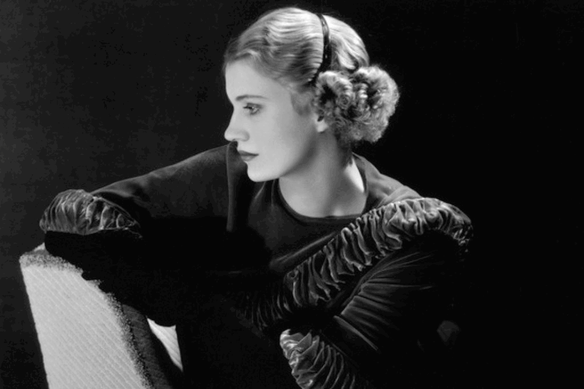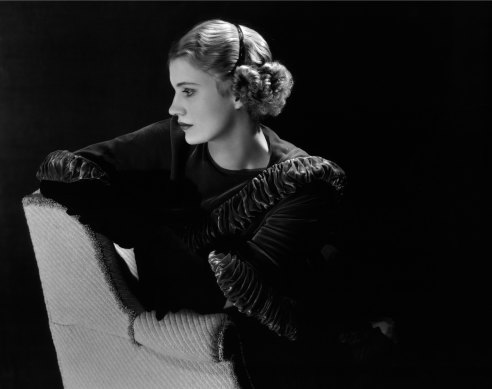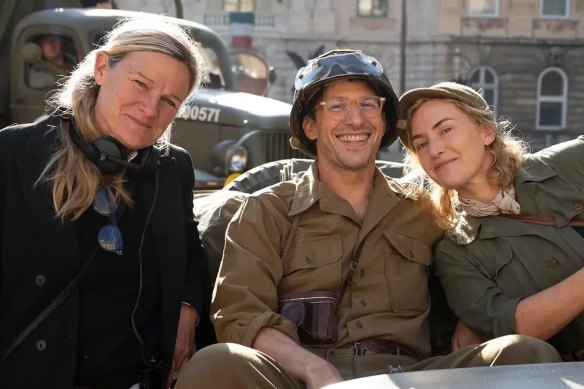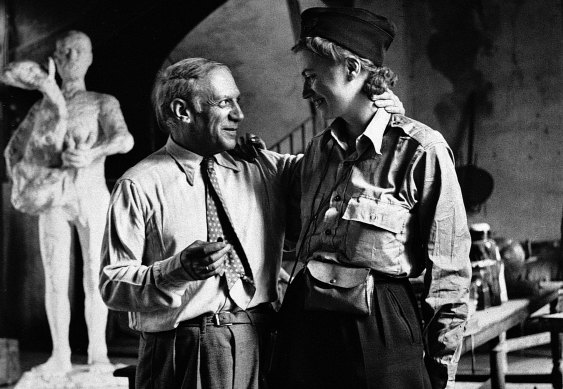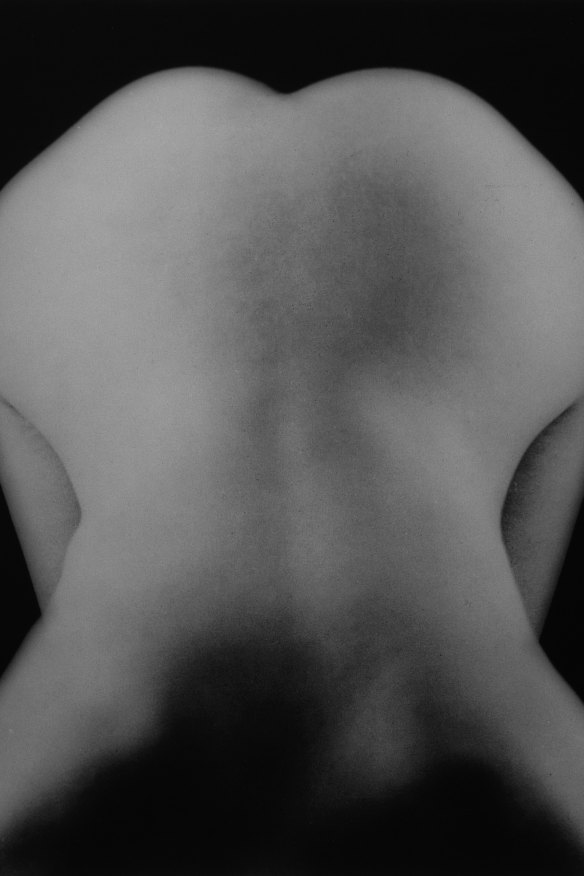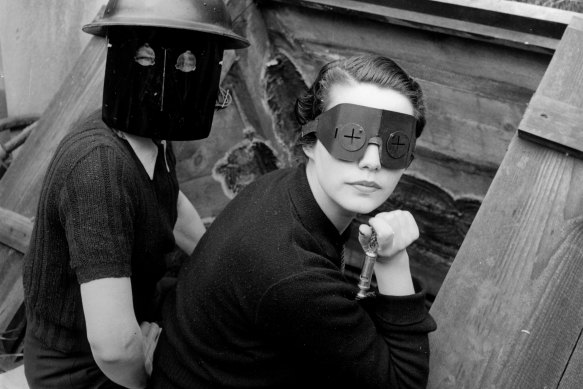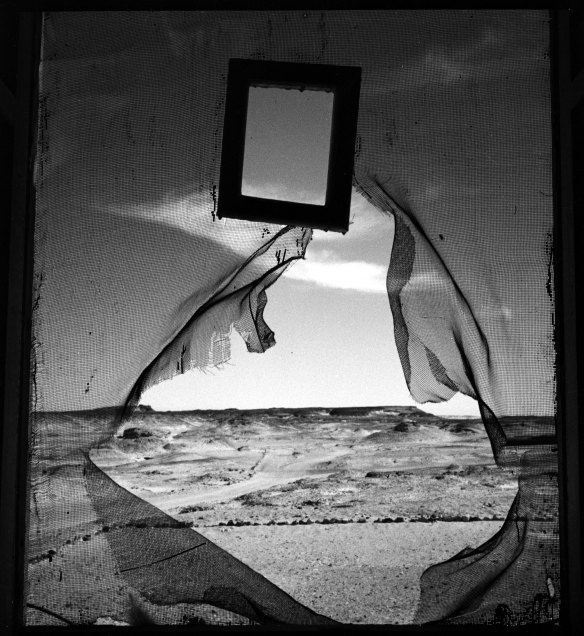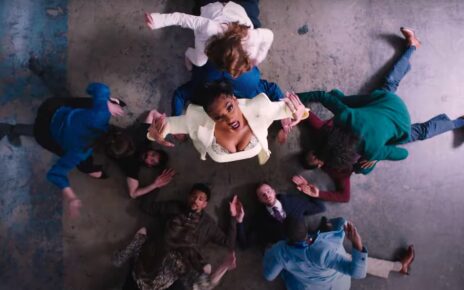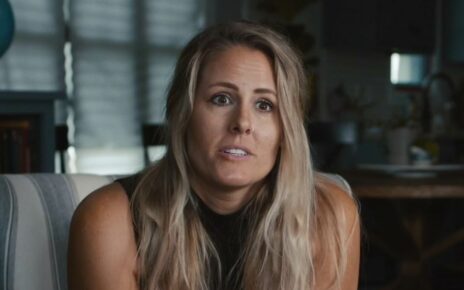By Kerrie O'Brien
Save articles for later
Add articles to your saved list and come back to them any time.
Lee Miller was in her early 20s when she wandered in front of a car on a busy New York street and was pulled back to safety by a stranger. He turned out to be Condé Nast, of the magazine empire that included Vanity Fair, Vogue and The New Yorker. Struck by her beauty, Nast would go on to help launch Miller’s career as a model, during which she was photographed by some of the world’s best, including Nickolas Muray and Edward Steichen. Along the way, she learnt to be a photographer.
Detail of Self portrait with headband, New York Studio, New York, USA c1932 by Lee Miller.Credit: © Lee Miller Archives England 2023
During her extraordinary life, the American shape-shifter went on to become an acclaimed war correspondent – at one point capturing the liberation of Paris – and a fine art and fashion photographer.
That Miller’s story and work lives on is something of a miracle. After her death in 1977, her son, Antony Penrose, unearthed 60,000 slides from the family attic. Until then, like much of the world, he knew little about his mother’s career; she had never spoken about it. Now, though, Miller is having a moment. Penrose’s book, The Lives of Lee Miller, forms the basis of Lee, a movie starring Kate Winslet in the title role.
Kate Winslet (right), as Lee Miller, on the set of Lee with director Ellen Kraus and co-star Adam Samberg.
Lee is the realisation of a decade-long dream for Winslet; she has said it’s a role she was born to play. In preparation, she spent time at Farleys House in Sussex, where Miller settled with her second husband, Roland Penrose. The house is now a museum, filled with art made by the couple’s friends, who included Picasso, Max Ernst and Joan Miró.
Miller’s work is also the subject of an exhibition opening at Heide Museum of Modern Art next month. Surrealist Lee Miller features more than 100 photographs, spanning portrait, fashion and surrealist photography in Paris and New York in the 1920s and ’30s, along with landscape, architecture and World War II.
Penrose’s book is a rollicking tale. During his research, he met many of her old friends in America and Europe. “It was so moving because I just wished I had known her better … I was just so emotionally overwhelmed by the feeling that I had not known enough of this person.”
Picasso and Lee Miller in his studio, Liberation of Paris, Rue des Grands Augustins, Paris, France 1944 by Lee Miller.Credit: © Lee Miller Archives England 2023
Penrose says truth was critical to Miller. As a child, she told him he could say what he wanted, so long as it was true. He also believes the trauma of being raped by a family friend when she was just seven led her to “assert herself so that nothing like that was ever going to happen to her again”. She became a champion of the oppressed, including victims of the Holocaust.
Heide’s head curator, Kendrah Morgan, who worked closely with Penrose to bring the exhibition to Australia, describes Miller as headstrong and independent. She defied the limitations and conventions placed on women at the time; although she was aligned with the surrealist movement, she didn’t strictly adhere to surrealist philosophies.
“A lot of the surrealist women were objectified, which she was in her own way at the time too, but she really set her own rules for life,” says Morgan.
Nude bent forward, Paris, France c1930 by Lee Miller.Credit: © Lee Miller Archives England 2023
Born in 1907 in Poughkeepsie, New York, Miller was christened Elizabeth but soon became known as Lee. Her father, Theodore, was an amateur photographer who taught her she could do anything she wanted in life. A rebellious teen, she was expelled from a number of schools and in 1925 convinced her parents that she should go to finishing school in Paris with a chaperone. Once there, she ditched the chaperone and enrolled in drama school, telling her parents she wanted to be an artist.
Paris was a hotbed of artistic revolution, Penrose writes in his book. “Dreams, hallucinations and fantasies were the fabric of the [surrealist] movement, libertarianism its style. Lee could not have sought her personal freedom at a more propitious moment.”
Fire Masks, Downshire Hill, London, England 1941 by Lee Miller.Credit: © Lee Miller Archives England 2023
In 1926, her father dragged Miller back to America, where she began modelling and learning techniques from the male photographers who captured her. A series of self-portraits from these years shows her own talent; her work soon garnered interest from Europe, where she returned in 1929.
In Paris, she began working with surrealist photographer Man Ray. They became a couple and she features in many of his most famous works; together they invented the solarisation technique. When they broke up, Man Ray created various artworks about Millerand they later became friends again; he would visit Farleys House, where she hosted surrealist dinner parties, including dishes such as cauliflower breasts and blue spaghetti.
When war broke out, there were few women correspondents, but for her the war was personal, says Penrose: she had many Jewish friends in France and was determined to play a part. No one would give her a gun, so she used the camera as her weapon. Speaking fluent French, she was an asset for the Allies.
Not only did she cover the war, says Morgan, she got into the action, even if at the beginning it was by chance. “There were no crews, they weren’t meant to be in combat, especially not the women … and then her humanity in being there, her empathy and helping everybody. As a woman, she was such a trailblazer. You’ve got to admire that, her tenacity; she spoke her truth.”
Though initially employed as a photographer for Vogue, Miller was soon writing as well. That eye for detail in visual art was also apparent in her journalism; she crafted beautiful, surprising metaphors. “But apparently she found writing, even though she was really good at it, really hard. And she would just procrastinate until the last minute,” Morgan says. “David Scherman when he was a war correspondent said that it was like putting his brain through a meat grinder trying to support her when a deadline was coming.”
Reporting on the liberation of Paris, she captured the city in ruins; she became one of the first photographers to use the now common idea of shooting high fashion among ruins.
In Munich on April 30, 1945, she and Jewish Life photographer Scherman were among the first to gain access to Hitler’s apartment. They set up a shot in the bathroom; Miller in the bath, with a propaganda photograph of the Fuhrer perched on the edge: it has since been described as one of the most controversial photographs of the 20th century.
The key thing is the muddy boots – that morning Miller had worn them around the hell that was Dachau concentration camp, Penrose says. “And now she is stamping the filth, the degradation, the horror of that place, she’s stamping that into Hitler’s nice, clean bath. And that proves that she’s not sitting there as a guest in his house – she’s actually a victor and it’s like she’s metaphorically grinding her heel into his face. What she and Scherman had no way of knowing was that at 4.45 that afternoon … in Berlin, Hitler and Eva Braun killed themselves.”
Some of Miller’s photographs of the concentration camps were not published in Britain and will hang in a separate room at the Heide show. “She was very upset that British Vogue didn’t run them,” Penrose says. The magazine’s editor, Audrey Withers, told him that they felt readers had endured too much suffering. “Lee was so disappointed by that because she wanted people to know what had happened because … that is probably the best defence against it happening again.”
Portrait of Space, Al Bulwayeb, near Siwa, Egypt 1937 by Lee Miller Credit: ©Lee Miller Archives England 2023
For Morgan, choosing a favourite Miller photograph is tricky. She loves the powerful and multi-layered Portrait of Space, which inspired Rene Magritte’s 1951 painting Le Baiser. It was shot towards the end of her time in Egypt, where she was living with her first husband, Aziz Eloui Bey.
It’s also one of Penrose’s favourites. “I think it’s a symbol of her longing for freedom because she was feeling very constrained at that time,” he says. “You can kind of get the feel of bursting through the flyscreen and tearing off down that desert road … And the little portrait frame, that’s the portrait of space. And that space is her gift to us, for us to populate with whatever dreams and imaginings we want to.”
Remington Silent, an image of a typewriter “smashed to smithereens”, is another highlight for Morgan. Shot during the Blitz in London, the photo documents the damage wrought by war but is also a play on the Remington Noiseless, a high-tech typewriter released before the war.
“And of course, here, it’s been rendered completely silent,” says Morgan. “She’s found that sense of the marvellous and the wonder in the everyday, but it’s also combined with the horror of war. It encapsulates her really incisive instinct to look at the ordinary and to find something extraordinary in it.”
Surrealist Lee Miller is at Heide from November 4 to February 25, 2024.
The Booklist is a weekly newsletter for book lovers from books editor Jason Steger. Get it delivered every Friday.
Most Viewed in Culture
Source: Read Full Article
